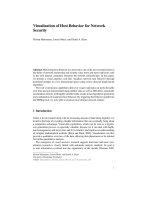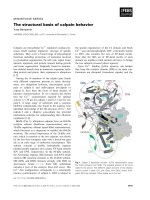CHAPTER 6METHODS OF MEASURING BEHAVIOR
Bạn đang xem bản rút gọn của tài liệu. Xem và tải ngay bản đầy đủ của tài liệu tại đây (366.09 KB, 31 trang )
CHAPTER 6
METHODS OF MEASURING BEHAVIOR
Nguyen Tien Dzung
Hanoi University of Science and Technology
Email:
Website:
Chapter Overview
1.
2.
3.
4.
5.
Deciding on a Method
Tests and Their Development
Types of Tests
Observational Techniques
Questionnaires
© 2012 NTD
Research Methods - Chapter 6
2
1. Deciding on a Method to Measure Behavior:
Some Important First Considerations
● Is the tool you propose to use reliable and valid?
● Base your choice of research tools on how you have
asked the research question
© 2012 NTD
Research Methods - Chapter 6
3
2. Tests and Their Development
● A test should measure the nature and extent of
individual differences
● A good test differentiates people based on true
scores
© 2012 NTD
Research Methods - Chapter 6
4
Why Use Tests?
●
●
●
●
●
Help determine outcomes of experiments
Can be used to diagnose strengths and weaknesses
Assist in placing individuals in appropriate programs
Assist in selecting applicants
Used to evaluate a program’s effectiveness
© 2012 NTD
Research Methods - Chapter 6
5
3. Types Of Tests: Overview
Types of Tests
What It Does
Achievement Test
Assesses an individual’s knowledge of a
specific area
Attitude Test
Assesses an individual’s feelings about
an issue
Personality Test
Assesses stable individual behavior
patterns
© 2012 NTD
Research Methods - Chapter 6
6
Achievement Test Sources
● Standardized
● Commercially prepared for wide use
● Scoring instructions included
● Researcher-made
● Designed by user for specific purpose
● Scoring instructions specific to test
© 2012 NTD
Research Methods - Chapter 6
7
Achievement Tests Referencing
What Comparison Do Tests Make?
● Norm-referenced—Individual’s scores are
compared to the scores of other individuals.
● Criterion-referenced—Individual’s scores are
compared to defined performance standards
© 2012 NTD
Research Methods - Chapter 6
8
Multiple-choice Achievement Items
Anatomy of a Multiple-Choice Item
12. Intelligence tests that are given to
preschool children
a. favor middle-class children
STEM
Clearly written
CORRECT
ANSWER
b. have questionable construct validity
c. are based on motor skills
d. are no fun at all
DISTRACTERS
Should be plausible (b & c), not easily ruled out (d)
© 2012 NTD
Research Methods - Chapter 6
9
To Use Or Not To Use?
● Advantages
●
●
●
●
●
●
● Disadvantages
Versatile
Easy to score
Simple to take
Poor writers not penalized
Good items used again
Good distracters are
diagnostic
● Hard to fake correct answer
© 2012 NTD
● Limit student’s options
● No opportunity to practice
writing
● Some people don’t do well
on them
● Limits content to be
assessed
● Items must be well written
Research Methods - Chapter 6
10
Item Analysis: How To Tell If Your
Items Work
● Questions should discriminate those who know the
material from those who don’t
● Item analysis provides two measures of a
question’s ability to discriminate
● Difficulty index
● Discrimination index
© 2012 NTD
Research Methods - Chapter 6
11
Computing Indices
First Steps
1. Rank scores from highest to lowest
2. Choose top 27% of scores for ―high‖ group
3. Choose bottom 27% of scores for ―low‖ group
© 2012 NTD
Research Methods - Chapter 6
12
Computing Indices
12. Intelligence tests that are given to preschool children
a. favor middle-class children
b. have questionable construct validity
c. are based on motor skills
d. are no fun at all
Item Alternative
A
B
C
D
Total
High Group
(n = 41)
23
12
4
2
41
Low Group
(n = 41)
11
9
15
6
41
Total
34
21
19
8
82
© 2012 NTD
Research Methods - Chapter 6
13
Computing Indices
Difficulty index
● Proportion who
answered item correctly
Discrimination index
● Proportion in high group who
answered correctly – proportion
in low group who answered
correctly
NCh NCl
D
T
NCh NCl
d
0.5T
NCh
= number of people in high group answering correctly
NCl
= number of people in low group answering correctly
T
= total number of people in high and low groups
© 2012 NTD
Research Methods - Chapter 6
14
Discrimination Level
Relationship Between Item Discrimination
and Difficulty
Perfect
+1.00
Discrimination
When:
Difficult,
Easy,
½ gets item
Good discrimination
Good discrimination
right,
½ gets item
wrong
0
&
50%
½ right is in
0%
100%
upper half,
Difficult,
Easy,
½ wrong is in
Poor discrimination
Poor discrimination
lower half
-1.00
Difficulty Level
© 2012 NTD
Research Methods - Chapter 6
15
Attitude Tests : Thurstone’s Scale
Item
Agree
No Strong
Feeling
Disagree
_____
_____
_____
_____
_____
_____
The dining room should serve
gourmet food.
_____
_____
_____
My parents don’t appreciate how
smart I am.
_____
_____
_____
My professors don’t appreciate
how smart I am, either.
_____
_____
_____
The day before Thanksgiving
should be a holiday.
Final exams should be elective.
© 2012 NTD
Research Methods - Chapter 6
16
Thurstone Scales
Method of Equal Appearing Intervals
● Statements indicating an attitude toward a topic are
written
● Judges rank the statements from least favorable to
most favorable
● Statements receiving consistent ratings are given
the average score
● A set of statements covering the entire range of
attitudes is selected
© 2012 NTD
Research Methods - Chapter 6
17
Thurstone Scales
Administration
● Respondents check items with which they agree
● Well-formed attitudes indicated by consistently checking
either high or low items
● Poorly-formed or inconsistent attitudes indicated by
inconsistent pattern or by checking off many neutral
items
© 2012 NTD
Research Methods - Chapter 6
18
Likert Scales
● Statements indicating an attitude toward a topic are
written
● Items with clearly positive or negative attitudes are
selected
● Statements are listed with a space for respondent
to indicate degree of agreement
© 2012 NTD
Research Methods - Chapter 6
19
A Likert Scale
Directions: Indicate to what extent you agree or disagree with the statements listed below by
circling one of the following:
SA means that you strongly agree with the statement
A means that you agree with the statement
U means that you are undecided about the statement
D means that you disagree with the statement
SD means that you strongly disagree with the statement
Item
Rating
Government has no business funding child care
programs.
SD
D
U
A
SA
Child care should be supported by federal, state,
and local tax dollars.
SD
D
U
A
SA
© 2012 NTD
Research Methods - Chapter 6
20
Scoring Likert Responses
Method Of Summated Ratings
Item
Rating
Government has no business funding
child care programs.
SD
D
U
A
SA
Child care activities are supported by
federal, state, and local tax dollars.
SD
D
U
A
SA
● Items are weighted
● Weights of unfavorable items are reversed
● Average score is computed
© 2012 NTD
Research Methods - Chapter 6
21
Personality Tests
● Projective tests
● Present respondent with ambiguous stimulus
● Structured tests
● Questions are objective
● Example: true-false, multiple choice, yes-no
© 2012 NTD
Research Methods - Chapter 6
22
4. Observational Techniques
● Researcher observes and records
● Does not interfere with behavior
© 2012 NTD
Research Methods - Chapter 6
23
Techniques For Recording Behavior
Technique
How it Works
Example
Duration
recording
The researcher records the
length of time that a behavior
occurs.
How much time is spent in verbal
interaction between two children?
Frequency
recording
The researcher records the
number of times a behavior
occurs.
How often are questions asked?
Interval
recording
The researcher observes a
subject for a fixed amount of
time.
Within a 60-second period, how
many times do members of the
group talk to another person?
Continuous
recording
The researcher records
everything that happens.
During a 1-hour period, all the
behavior of a 6-year-old boy is
recorded.
© 2012 NTD
Research Methods - Chapter 6
24
Observational Techniques? Be Careful!
● Pitfalls to Avoid
●
●
●
●
© 2012 NTD
Observer effects
Observer bias
Fatigue
Changing definitions
Research Methods - Chapter 6
25









